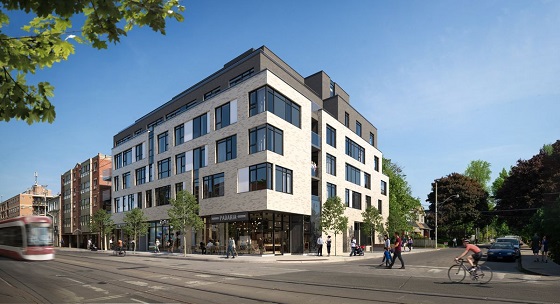 Thursday, October 3, 2024
Thursday, October 3, 2024  Thursday, October 3, 2024
Thursday, October 3, 2024 
Earlier this month, the Toronto-based developer Hullmark cut the ribbon on a modest 45-unit mid-rise project in Leslieville, a development that had been three years in the making.
Because the building is situated on an intimate stretch of Queen Street East, with single-family homes behind, the company had to adhere to a city urban-design policy known as the Mid-Rise Guidelines. These don’t pack the regulatory punch of formal zoning or official plan regulations, but nonetheless impose “performance standards” on such projects. Those frequently involve inclined step-backs – or “articulations” – on both the front- and rear-facing sides to prevent shadows and perceived privacy intrusions (known in planning parlance as “overlook”), while creating a visual transition to low-rise neighbourhoods.
If builders want to avoid a protracted fight with the city or local homeowners, they try to adhere to these guidelines. In this case, senior vice-president of development Leona Savoie says, Hullmark met 98 per cent of the expectations, which are itemized in a detailed document last updated by the planning department in 2016.
Yet, according to Ms. Savoie, the company encountered a quirk in these non-regulatory regulations. While the Mid-Rise Guidelines are ostensibly a city-wide policy, council approved a bespoke version just for Leslieville. Hullmark officials then looked at some of its other landholdings on West Queen West and discovered the planning department is working on a similarly localized version for that area.
“That was the first time we encountered a new neighbourhood-based guideline that took precedent over the city-wide policy,” she says.
While these revelations may sound like the development industry’s version of inside-baseball, they hint at an increasingly untenable economic dilemma embedded in the city’s long-standing vision for intensification, and therefore its ability to create new housing.
Keep reading in The Globe and Mail
Check out more news below: